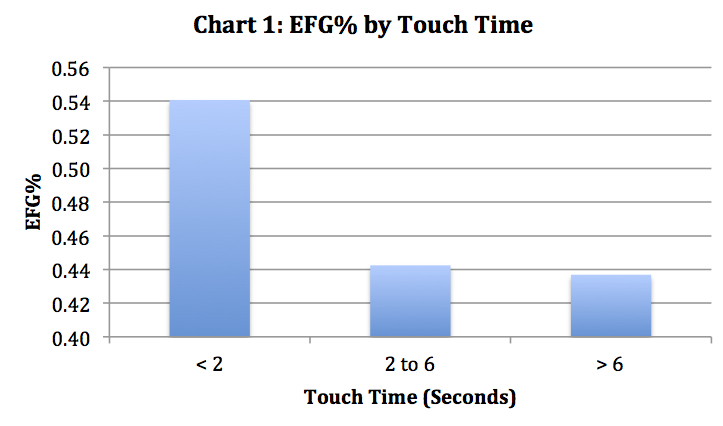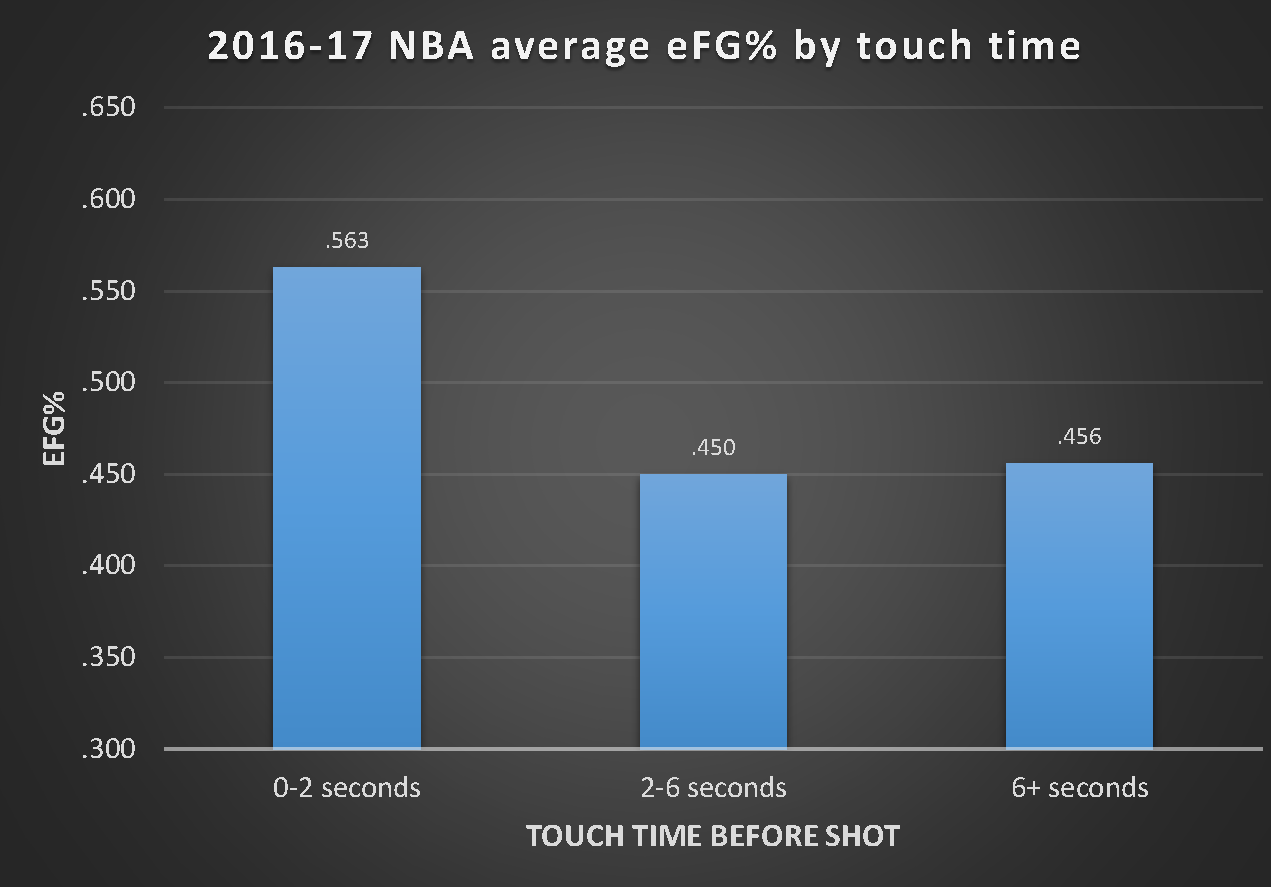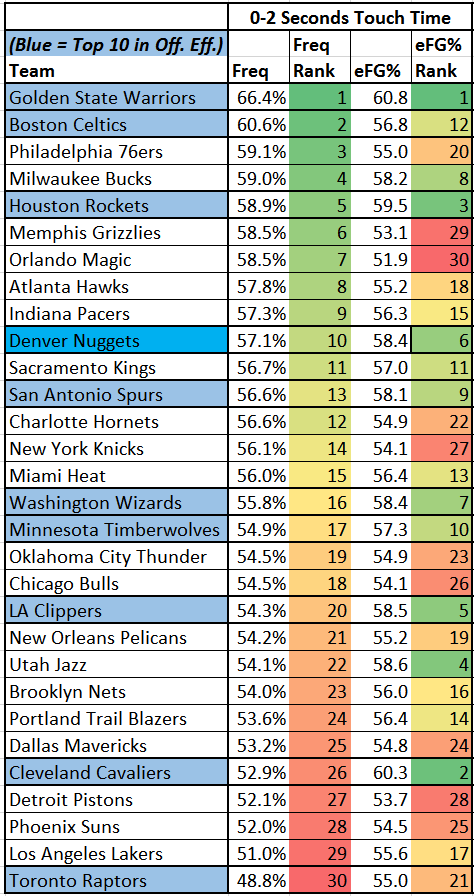© 2024 ALLCITY Network Inc.
All rights reserved.

By now it’s no secret that when Nikola Jokic took the helm as the Denver Nuggets’ starting center, the team transformed into an offensive juggernaut rivaling the league’s best. Denver finished the season with an offensive rating of 110.0, good for fifth in the league, but improved to an NBA-best 113.3 from the Dec. 15 dawn of the Jokic era to the end of the season.
Much of the focus on how the Nuggets can improve next season has, therefore, turned to their defense, which with a defensive rating of 110.5, was second-worst in the league. But their highly efficient 2016-17 offense cannot be simply assumed as a given. Replacing the offensive production of now-departed free agent Danilo Gallinari will not necessarily be easy.
Even if newly-signed four-time All-Star Paul Millsap can be viewed as an upgrade, per game Gallinari led Denver in points (18.2), three-pointers (2.0), and importantly free throws, where his 5.5 more than doubled the next player Jokic, who had 2.6. Just as significantly, from Dec. 15, Gallinari had Denver’s highest offensive rating (118.0), net rating (7.5), and true shooting percentage (.648), edging out Jokic in all three categories. So even if Millsap meshes more quickly with his new team, which seems likely after a somewhat awkward chemistry through five preseason games, it may not be realistic to expect him to replicate the sheer volume and efficiency of Gallinari’s production on offense.
That possibility, in turn, raises the question of how one of the league’s best offenses from last season might find ways to maintain its efficiency and curb potential drop-off resulting from Gallinari’s departure. To that end, reducing the touch time players have the ball before shots is one area which the Nuggets could target as an area for improvement, as it is highly compatible with their style of play.
Limiting touch time before shots
Nearly three years ago, in December of the 2014-15 NBA season, Stephen Shea did an analysis of tracking data from SportVU at NBA.com/stats on player touch time before shots and its relationship to effective field goal percentage (eFG%). You can read his piece in its entirety here, which I highly recommend. The data showed that “shots after less than 2 seconds of touch time have the highest EFG% by a significant margin,” as Shea illustrated in the following chart: At the time, Shea advised caution in the interpretation of this data, as it had just recently been introduced, and it was only a month and a half into the season, making for a relatively small sample size. But considering all of that, his findings on the correlation between eFG% and touch time before shots are markedly consistent with data I compiled from the entire 2016-17 season:
At the time, Shea advised caution in the interpretation of this data, as it had just recently been introduced, and it was only a month and a half into the season, making for a relatively small sample size. But considering all of that, his findings on the correlation between eFG% and touch time before shots are markedly consistent with data I compiled from the entire 2016-17 season: The overall pattern remains constant. Just as in Shea’s sample, shots taken in 2016-17 with a touch time of under two seconds had an eFG% which is 10 percent or more higher than when the touch time was over two seconds.
The overall pattern remains constant. Just as in Shea’s sample, shots taken in 2016-17 with a touch time of under two seconds had an eFG% which is 10 percent or more higher than when the touch time was over two seconds.
Interestingly however, while this would seem to suggest the possibility that any team could improve its offensive efficiency by taking a higher percentage of its shots with a touch time under two seconds (hereafter referred to as “TT<2s”), this is not always the case, or at least was not last season. In fact, the Toronto Raptors, whose 48.8 percent was the very lowest TT<2s frequency, had the league’s sixth highest offensive efficiency (109.8). And while it is also true that the Golden State Warriors, who led the league in offensive efficiency (113.2) also had the highest percentage of shots with a touch time under two seconds by a very wide margin at 66.4 percent, the top ten offenses in the NBA were fairly evenly distributed across the entire spectrum of touch time before shots, as they can be seen highlighted in blue in this chart:
 In fact, half the top ten teams in offensive efficiency were in the bottom 15 in TT<2s frequency, including the Cleveland Cavaliers, whose 110.9 offensive efficiency was the league’s third-best.
In fact, half the top ten teams in offensive efficiency were in the bottom 15 in TT<2s frequency, including the Cleveland Cavaliers, whose 110.9 offensive efficiency was the league’s third-best.
So why do we not see a closer correlation overall between higher offensive efficiency and reduced touch time? The answer seems to lie in the offensive play styles and schemes of specific teams. The clearest example here is the Raptors, who stand in starkest contrast to that expectation as the team with the lowest frequency TT<2s: Toronto’s relatively slow-paced offense, which features heavy doses of Kyle Lowry and DeMar DeRozan isolations in the halfcourt, was actually elite in eFG% when there was over two seconds of touch time before the shot, ranking second in eFG% when touch time was between two and six seconds, and first when it was over six seconds. This should come as little surprise, as both DeRozan (1.02) and Lowry (1.01) were top ten in points per possession (PPP) in isolation scoring among players with two or more iso possessions.
Toronto’s relatively slow-paced offense, which features heavy doses of Kyle Lowry and DeMar DeRozan isolations in the halfcourt, was actually elite in eFG% when there was over two seconds of touch time before the shot, ranking second in eFG% when touch time was between two and six seconds, and first when it was over six seconds. This should come as little surprise, as both DeRozan (1.02) and Lowry (1.01) were top ten in points per possession (PPP) in isolation scoring among players with two or more iso possessions.
And considering that the Raptors were in the bottom third in eFG% on shots with TT<2s, resulting in the league’s biggest discrepancies between under and over two second touch time eFG%, it seems reasonable to infer that if they had increased their frequency of TT<2s shots, it would actually have had a negative impact on their offensive efficiency.
We see a similar if less pronounced situation with the Cavaliers: Although the Cavs are elite across with board, with top-three eFG% in all touch time categories, the fact that they are third when touch time is over two seconds – due primarily to the frequency and efficiency of isolation scoring by LeBron James and Kyrie Irving – means that their offense would have been elite irrespective of touch time distribution. Therefore, the more iso-heavy halfcourt style of play which best suited their personnel was for Cleveland, like Toronto, a benefit to their offensive efficiency rather than a detriment.
Although the Cavs are elite across with board, with top-three eFG% in all touch time categories, the fact that they are third when touch time is over two seconds – due primarily to the frequency and efficiency of isolation scoring by LeBron James and Kyrie Irving – means that their offense would have been elite irrespective of touch time distribution. Therefore, the more iso-heavy halfcourt style of play which best suited their personnel was for Cleveland, like Toronto, a benefit to their offensive efficiency rather than a detriment.
At the opposite end of the spectrum are the Golden State Warriors: Like Cleveland, Golden State was highly efficient in scoring in all three touch time categories, and could therefore likely have an elite offense regardless of touch time frequencies. (I did not dig into playoff numbers, but presumably, their high eFG% in shots with over two seconds of touch time would be a huge boon when the game slows down in the postseason.)
Like Cleveland, Golden State was highly efficient in scoring in all three touch time categories, and could therefore likely have an elite offense regardless of touch time frequencies. (I did not dig into playoff numbers, but presumably, their high eFG% in shots with over two seconds of touch time would be a huge boon when the game slows down in the postseason.)
Of course, the Warriors’ style of play is radically different from that of the Cavs and is based largely on the ability of their deadly three-point shooters to get off shots in a flash off screens — as evidenced by the term “quick release” being ubiquitous in descriptions of Golden State’s offense. So while they theoretically could maintain an elite offense while taking fewer TT<2s shots, they wisely accentuate their strengths by doubling down on what they’re best at, taking nearly two-thirds of their shots with a TT<2s, a full six percent more than the second-ranked Boston Celtics.
Back to the Nuggets. Looking first here at the far right columns on the chart, the Nuggets had some of the league’s biggest discrepancies between their TT<2x eFG% (58.4%) and their eFG percentages with over two seconds or six seconds of touch time (45.2% and 45.1%, respectively). And while the latter two categories found Denver in the middle of the pack in the league in eFG% on shots with over two seconds of touch time, they were an elite sixth on TT>2s shooting efficiency.
Looking first here at the far right columns on the chart, the Nuggets had some of the league’s biggest discrepancies between their TT<2x eFG% (58.4%) and their eFG percentages with over two seconds or six seconds of touch time (45.2% and 45.1%, respectively). And while the latter two categories found Denver in the middle of the pack in the league in eFG% on shots with over two seconds of touch time, they were an elite sixth on TT>2s shooting efficiency.
The Nuggets did do a great job of minimizing shots with over six seconds of touch time, finishing 27th in that frequency. However, they had the 11th highest frequency of shots taken with between two and six seconds of touch time and were tenth in TT>2s shot frequency. The difference between eFG% in those two categories – a whopping 13.2 percent – is large enough that shifting a larger percentage of shots taken to the TT>2s column should have a significantly positive impact on Denver’s offensive efficiency.
But beyond the numbers, this also just makes sense for Denver’s style of offensive play, which is based on maximizing ball sharing, and ball and player movement. The Nuggets did an amazing job last season, with the help of Jokic, at discovering that their most lethal shots were cuts to the basket off dribble hand-offs and pick-and-rolls, and three-pointers after a series of passes found great open looks. All of this was predicated on superb player and ball movement. And just as the Warriors lean full bore into their players’ strengths by maximizing quick-release three-pointers off screens, one way for Denver to increase the positive impact of its most effective offensive attributes is to increase the frequency of TT>2s shots in their offense, while decreasing the frequency of shots taken with over two seconds of touch time.
One thing this means in practical terms is that every single one of Denver’s point guards has to cut down on over-dribbling the ball without a clear purpose, a practice which all too often leads to undesirable, inefficient shots. The biggest culprit in this regard last season was Jameer Nelson, who took Denver’s highest frequency of shots with over six seconds of touch time at 22.2 percent, followed by Will Barton at 15.9, Emmanuel Mudiay at 15.5, and Jamal Murray at 14.5 percent. Granted, this is somewhat “all in the game” for primary ball handlers, as having the ball in possession longer they are more likely to get stuck with it, too.
But anyone who watched a lot of Nuggets games last season could easily see plenty of over-dribbling from all of Denver’s point guards and this was doubly frustrating considering how much more adeptly Jokic was able to create fantastic scoring opportunities once he got the ball in his hands.
So can the Nuggets reduce their touch time before shots? Initially, the addition of Millsap could be an impediment to this, and players — especially he and Jokic — acclimate and develop chemistry, which if the preseason is any indication, will not happen overnight. But being that Millsap is such a great passer and playmaker, once the new semblance of players jells, the ball and player movement should click into place.
And with more experience now under the Jokic-led offense, there should also just be a higher level of awareness and confidence about how to operate within Denver’s offensive system, and therefore less hesitation and better, quicker decision-making all around. So there is good reason to believe that reducing touch time is an accomplishable goal for the Nuggets.
If on the other hand, we see a decline in Denver’s offensive efficiency, it will perhaps be instructive to check back in on these touch time stats to see if they might be playing a factor.
Comments
Share your thoughts
Join the conversation



